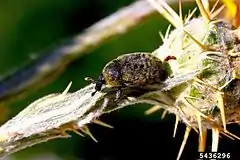Larinus curtus
Larinus curtus is a species of true weevil known as the yellow starthistle flower weevil. It is native to Southern Italy, Southern Europe, the Middle East and the Caucasuses.[1] It is used as an agent of biological pest control against the noxious weed yellow starthistle (Centaurea solstitialis) in the United States.
| Yellow starthistle flower weevil | |
|---|---|
 | |
| Scientific classification | |
| Kingdom: | |
| Phylum: | |
| Class: | |
| Order: | |
| Family: | |
| Subfamily: | |
| Genus: | |
| Species: | L. curtus |
| Binomial name | |
| Larinus curtus Hochhut | |
The adult weevil is dark brown or black with light colored mottled hairs on its body. It is about 6 millimetres (1⁄4 in) long. The female lays glossy, milky white, oval-shaped eggs at the bases of open yellow starthistle flowers.[1] The larva emerges from its egg in a few days and goes inside the flower head, where it feeds on the developing seeds. A larva is capable of destroying all of the seeds inside a given head, with an average reduction of 96%.[1] The adult feeds on flowers and pollen but probably does little damage to the plant. It is the larva's impact on seed production that helps control the plant's spread.[1]
There have been field reports of large numbers of adult L. curtis feeding on safflower flowers Carthamus tinctorius, but no evidence that larvae have successfully developed on this plant.[2]
This weevil is native to southern Europe and the Mediterranean. It was first introduced to the United States as a biocontrol agent in 1992.[2] It is now established throughout the Pacific Northwest, but in relatively low densities.[3]
References
- Sobhian & Fornasari (1994). "Biology of Larinus curtus Hochhut (Coleoptera: Curculionidae) a European weevil for Biological Control of Yellow Starthistle Centaurea solstitialis L. (astereraceae) in the United States" (PDF). Biological Control. Archived from the original (PDF) on 2011-07-21. Retrieved 2009-12-18.
- S.L. Clement; L.J. Smith; J. Prena; M.D. Kleene; R.C. Johnson (April 2009). "Non-target plant use by a weed biocontrol agent in idaho: host expansion or opportunistic behavior?" (PDF). Biocontrol Science and Technology. Archived from the original (PDF) on 2011-07-21. Retrieved 2009-12-18.
- Smith; Cristofaro; Tronci; Hayat (2007). "Evaluation of the rosette weevil Ceratapion basicorne, a new biological control agent of yellow starthistle" (PDF). cal-ipc. Archived from the original (PDF) on 2015-09-23. Retrieved 2009-12-18.
- Coombs, E. M., et al., Eds. (2004). Biological Control of Invasive Plants in the United States. Corvallis: Oregon State University Press, 429.
External links
- USACE Biocontrol Profile
- https://web.archive.org/web/20150923195902/http://www.cal-ipc.org/symposia/archive/pdf/2007/4.1biocontrol-smith.pdf